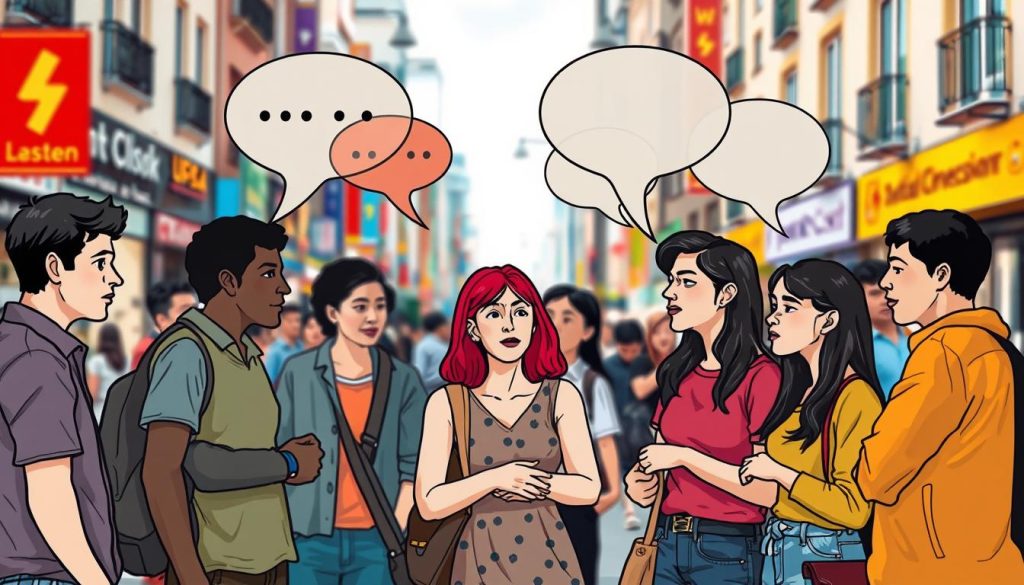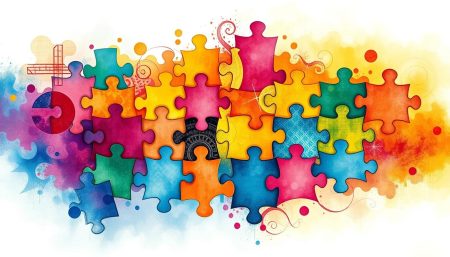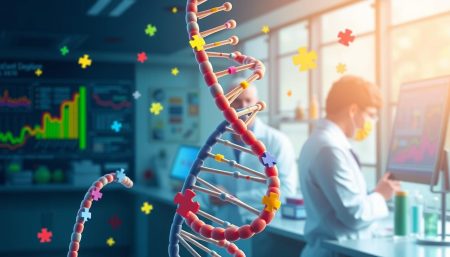The field of mental disorder classification is always changing. The Diagnostic and Statistical Manual of Mental Disorders (DSM) gets more detailed with each new edition. The fifth edition (DSM-5) by the American Psychiatric Association brought big changes to the DSM 5 autism spectrum disorder criteria. These changes have reshaped how we diagnose Autism Spectrum Disorder (ASD).
This section will explain the detailed updates in the DSM-5. We’ll look at the updated diagnostic guidelines for ASD and how they affect treatment plans.
The new criteria reflect the latest research and the need for accurate diagnoses. These changes are important for everyone involved in finding and supporting people with ASD.
The DSM-5 moves away from one-size-fits-all approaches. It now uses a spectrum-based method that recognizes the wide range of ASD symptoms. By exploring these criteria, we aim to provide a diagnosis that is both accurate and helpful. This will help individuals get the support and services they need.
Understanding Autism Spectrum Disorder in DSM 5
The DSM-5 update has changed how we diagnose Autism Spectrum Disorders (ASD). It now offers a more inclusive and detailed approach. This section explores the autism diagnosis criteria DSM 5 and how they improve ASD classification.
The DSM-5 puts ASD under one umbrella. It merges autistic disorder, Asperger’s syndrome, and other disorders into one category. This change makes diagnosis easier and ensures consistent care for all.
- Focus on social communication and interaction across multiple contexts.
- Recognition of restricted, repetitive patterns of behavior, interests, or activities.
The autism diagnosis criteria DSM 5 are key because they reflect the diversity of ASD. These updates help tailor healthcare and education to fit individual needs better.
| Previous Criterion | DSM-5 Criterion | Impact on ASD diagnosis |
|---|---|---|
| Separate categories for different disorders | Single spectrum | Broader, more inclusive diagnosis |
| Diagnostic criteria less defined | Clearer criteria based on updated research | Improved specificity in diagnosis |
| Less emphasis on sensory sensitivities | Includes sensory issues in criteria | Better recognition of sensory challenges |
The ASD classification in DSM-5 also emphasizes sensory sensitivities. This gives doctors a better tool to identify and meet the needs of those with ASD. With these clear criteria, professionals can now better support individuals with ASD, making a big leap in mental health.
Essential Components of DSM 5 Autism Diagnosis
The diagnostic criteria for autism spectrum disorder DSM 5 focuses on two main areas. These are persistent social communication and interaction deficits, and restricted, repetitive behaviors. These elements are key to understanding ASD and show the need for a detailed assessment.
The criteria look at how often and how much these behaviors affect daily life. A diagnosis relies on careful observations and detailed histories. This information comes mainly from caregivers, giving insight into the individual’s social and educational life.
| Core Diagnostic Area | Description of Impact |
|---|---|
| Persistent deficits in social communication and social interaction | This involves difficulties in sharing emotions, understanding social cues, and maintaining relationships. It is a fundamental aspect that appears across all settings (home, school, community). |
| Restricted, repetitive patterns of behavior, interests, or activities | Manifests as repetitive motor movements, inflexible adherence to routines, or overly focused interests. These behaviors disrupt daily activities and social interactions. |
It’s important for professionals to understand these diagnostic components. This helps them accurately identify and support individuals with ASD. The diagnostic criteria for autism spectrum disorder DSM 5 helps in recognizing ASD accurately. It also shows the complexity of ASD, requiring a personalized approach to each diagnosis.
The Evolution of Autism Diagnosis from DSM-IV to DSM-5
The move from DSM-IV to DSM-5 is a big step forward in understanding autism spectrum disorder (ASD). This change shows how science has grown and our view of autism has become more detailed.
Historical Perspectives on Autism Diagnosis
At first, the DSM-IV split autism into different disorders. These included autistic disorder, Asperger’s syndrome, and PDD-NOS. Each had its own set of rules, making diagnosis a bit complicated.
Comparative Analysis of Criterion Changes
The DSM-5 changed this by merging all into one diagnosis: autism spectrum disorder. This change aimed to make diagnosis better by focusing on the spectrum of autism, not just separate parts.
| Aspect | DSM-IV | DSM-5 |
|---|---|---|
| Number of Categories | Several (Autistic Disorder, Asperger’s Syndrome, PDD-NOS) | One (Autism Spectrum Disorder) |
| Core Symptoms | Classified separately (Social, Communication, Behavioral) | Combined (Social Communication and Interaction, Restrictive Behaviors) |
| Diagnostic Threshold | Specific to each category | Unified criteria with severity levels |
| Inclusion of Sensory Issues | Not included | Included under Restrictive Behaviors |
The dsm 5 criteria for autism spectrum disorder were made to fit the wide range of autism. This important change in evolution in ASD diagnosis helps us better understand and recognize autism behaviors.
dsm 5 autism spectrum disorder criteria
The dsm 5 autism spectrum diagnostic criteria are key for diagnosing Autism Spectrum Disorder (ASD). They outline important elements for assessment. These include behaviors in two main areas: “Social Communication and Social Interaction” and “Restricted, Repetitive Patterns of Behaviors, Interests, or Activities.”
It’s vital for caregivers and healthcare professionals to grasp these criteria. The ASD diagnosis guidelines from DSM-5 help ensure accurate diagnosis and support. They provide clear signs that must be met for an ASD diagnosis.
- Persistent deficits in social communication and social interaction across multiple contexts.
- Restricted, repetitive patterns of behavior, interests, or activities.
- Symptoms must be present in the early developmental period.
- Symptoms cause clinically significant impairment in social, occupational, or other important areas of current functioning.
- These disturbances are not better explained by intellectual disability or global developmental delay.
The dsm 5 autism spectrum diagnostic criteria require symptoms to be observed or verified during assessments. Using these guidelines helps understand ASD’s impact on an individual’s life.
| Criteria | Description | Examples |
|---|---|---|
| Social Communication and Interaction | Deficits in social-emotional reciprocity, nonverbal communicative behaviors, and developing, maintaining, and understanding relationships. | Difficulty in sharing interests, emotions, or affect; reduced sharing of emotions through facial expressions and gestures. |
| Restricted Interests & Repetitive Behaviors | Manifests in stereotyped or repetitive motor movements, insistence on sameness, inflexible adherence to routines, or hyper- or hypo-reactivity to sensory input. | Repetitive use of objects, excessive adherence to routines, or unusual responses to sensory experiences like indifference to pain/temperature. |
Social Communication and Interaction Criteria
Autism Spectrum Disorder (ASD) is complex, with communication challenges in autism being a big part. The DSM 5 criteria ASD helps diagnose and manage these issues. It provides clear guidelines for understanding and addressing social communication and interaction problems.

Now, let’s explore the DSM 5 criteria ASD for social communication. It has three main parts:
Difficulties in Social-Emotional Reciprocity
This part of the DSM 5 criteria looks at the lack of back-and-forth conversation. People with autism might find it hard to start or join in social talks. They also might not respond well to others’ attempts to connect, which is key in social interactions.
Nonverbal Communicative Behaviors in Autism
Nonverbal communication includes eye contact, facial expressions, and body language. Autism makes it tough for people to understand and use these cues. This is a big part of how we interact every day.
Developing and Maintaining Relationships
Creating and keeping up healthy relationships is hard, as the DSM 5 criteria shows. It’s tough to read social signals and adjust how we act. This makes it hard for people with autism to build lasting connections.
Using these criteria helps us understand autism better. It also shows why we need special help for these challenges. Support is key from when we’re young to when we’re grown up.
Restrictive, Repetitive Patterns of Behavior
One key part of the DSM 5 autism criteria is spotting restrictive and repetitive behaviors. These are key behavioral symptoms of ASD. They show up in many ways and affect daily life.
| Type of Behavior | Description | Examples |
|---|---|---|
| Repetitive Motor Movements | Simple actions that are repeated and seem ritualistic. They don’t seem to serve a purpose. | Hand flapping, rocking, spinning |
| Inflexible Adherence to Routines | People with ASD often resist changes. They stick to their routines very closely. | Extreme upset at small changes, strict thinking, greeting rituals |
| Fixated Interests | They focus intensely on specific topics. This focus is often too much or too little. | Being very interested in certain topics, like trains or historical dates |
| Sensory Hypo- or Hyper-reactivity | They might be too sensitive or not sensitive enough to what’s around them. | Dislike of certain sounds or textures, or being drawn to lights or spinning things |
Knowing about these patterns from the DSM 5 autism criteria helps spot ASD early. Helping with these behavioral symptoms of ASD can really help them connect with the world.
Clinical Examples of DSM 5 Criteria in Action
Real-world case studies show how the DSM 5 is used in clinical practice. They give us a look at how DSM 5 application in clinical practice works. These examples highlight the methods and results of diagnosing autism spectrum disorder (ASD).
A pediatric psychologist once evaluated a four-year-old with speech delays and social issues. It was important to tell if it was ASD or something else. The psychologist looked at ASD diagnostic examples to check for social communication problems and repetitive behaviors.
- Analysis of social engagement behaviors, comparing them with benchmarks outlined in DSM 5.
- Observation of play habits, noting any repetitive actions or fixations.
- Interviews with caregivers to further understand developmental history and family dynamics.
By using these methods, the psychologist got a full picture. This led to a clear ASD diagnosis.
Another case was about older children, where the differences between ASD and other conditions were harder to see. A team of experts did many assessments. They used direct and indirect observations to collect data for the DSM 5 ASD criteria.
- Evaluation of nonverbal communication skills and adaptability to social contexts.
- Assessment of interest spectrum and response to environmental stimuli.
- Extensive review of educational and medical history.
Every case shows how important it is to tailor assessments to the DSM 5. It shows that understanding and applying these guidelines is as varied as the spectrum itself. So, sharing ASD diagnostic examples is key to improving diagnosis and care.
Distinguishing Autistic Spectrum Disorder from Other Conditions
Identifying Autism Spectrum Disorder (ASD) in clinics is more than just spotting its signs. It also means doing a detailed differential diagnosis to tell it apart from other developmental disorders. The DSM-5 has clear criteria for diagnosing ASD accurately and starting the right treatment. But, ASD symptoms can look like those of other conditions, making it hard to know what’s unique about ASD.
Exclusion Criteria for Autism Diagnosis
The DSM-5 has strict rules to make sure ASD is diagnosed correctly. For example, if a child’s delays are just because of a global developmental delay, they might not have ASD unless they show ASD distinct diagnostic features later. Also, if a child has trouble talking but doesn’t have repetitive behaviors or special interests, it might not be ASD.
Comorbidity with Other Developmental Disorders
Diagnosing ASD gets even trickier because it can happen with other developmental disorders like ADHD and learning disabilities. Doctors have to check for all possible conditions carefully. This way, they make sure each symptom is looked at in the context of ASD and other possible disorders. This helps choose the right treatments and support.
| Condition | Overlap with ASD | Differentiation Strategy |
|---|---|---|
| ADHD | Attention issues, hyperactivity | ADHD does not feature restrictive/repetitive patterns of behavior |
| Learning Disabilities | Challenges in academic achievement | Focus on specific learning delays, not pervasive social deficits |
| Anxiety Disorders | Social withdrawal | Anxiety disorders lack repetitive behaviors characteristic of ASD |
Severity Levels and Specifiers in Autism Diagnosis
The DSM-5 introduces new ways to classify Autism Spectrum Disorder (ASD). It uses an autism severity scale and specifiers for individualized diagnosis. This helps detail the support needs of individuals, showing the spectrum nature of ASD.
Understanding the autism severity scale and specifiers for individualized diagnosis is key. Clinicians use this to create targeted and effective treatment plans. It shows the importance of tailoring care to each person’s unique needs.
- Level 1 ‘Requiring Support’
- Level 2 ‘Requiring Substantial Support’
- Level 3 ‘Requiring Very Substantial Support’
Each level shows the severity of social communication and repetitive behaviors in ASD. The higher the level, the more support needed.
| Specifier | Description | Implications for Treatment |
|---|---|---|
| With or without accompanying intellectual impairment | Identifies if the individual has intellectual challenges with ASD, affecting interventions. | More personalized learning strategies, possibly including speech and occupational therapy. |
| With or without language impairment | Shows if there’s a significant language delay separate from ASD. | Focused language and communication therapies to improve verbal skills. |
| Associated with a known medical or genetic condition | Links the diagnosis with genetic factors or existing medical conditions, affecting treatment. | Integrated healthcare approach involving genetic counseling and managing comorbid conditions. |
| Associated with another neurodevelopmental, mental, or behavioral disorder | Flags additional diagnoses needing simultaneous management. | Coordinated care plan addressing multiple health aspects. |
| Associated with catatonia | Highlights catatonic features that may complicate ASD management. | Use of both behavioral interventions and medication for symptom management. |
The use of the autism severity scale and specifiers clarifies needs and fosters understanding among caregivers and educators. It helps tailor interventions and improve the quality of life for those with ASD.
Practical Implications of DSM 5 Criteria for Caregivers
The DSM 5 criteria have big changes for caregivers. Knowing these criteria helps support people with Autism Spectrum Disorder (ASD) better. We look at how these guidelines affect daily life, getting services, and working with doctors.
Understanding ASD for families starts with knowing how DSM 5 affects getting services. These criteria decide who gets into school programs, therapy, and financial help. Caregivers can fight for their loved ones better when they know the criteria well.
| Aspect of Care | Impact of DSM 5 Understanding |
|---|---|
| Access to Educational Services | Understanding aids in securing appropriate educational adjustments. |
| Therapeutic Interventions | Criteria guide the selection of targeted interventions. |
| Financial Assistance | Eligibility often hinges on diagnosis per DSM 5 standards. |
The DSM 5 criteria impact on caregivers also affects daily life and managing ASD symptoms. Knowing these criteria helps caregivers spot and understand behaviors. This leads to quicker and more fitting responses to their loved ones’ needs.
- Enhanced ability to recognize symptom onset early.
- Better strategies for managing daily challenges.
- Improved communication with healthcare providers.
Being a caregiver means working closely with experts. This partnership gets stronger when both sides understand ASD well. This understanding helps make healthcare plans that fit the unique ASD challenges, as seen in the DSM 5.
Assessment Process for Autism Under DSM 5 Guidelines
The DSM 5 has a detailed plan for checking if someone has autism. It uses strict autism assessment protocols and follows the DSM 5 evaluation process. This helps move from first thoughts of autism to a clear diagnosis.
First, screenings are done in schools or doctor’s offices. These are key for catching autism early. If signs show up, more detailed checks follow.
- Developmental screenings by pediatricians
- Standardized behavior questionnaires
- Ongoing observations at school or home environments
Then, a team of experts like psychologists and speech therapists does a deep dive. They look at the child’s behavior, skills, and needs. This detailed check is key to getting a full picture of the child.
- Detailed developmental history taken from parents
- Behavioral assessments performed in controlled settings
- Neurological evaluations to rule out other conditions
- Interviews or questionnaires filled out by caregivers
Family members play a big role in this process. They share important info and support. Their views on the child’s daily life and how they react to the world help make a correct diagnosis.
Integrative Strategy for Applying DSM 5 Criteria
Diagnosing autism spectrum disorder (ASD) needs a team effort. This team includes doctors, psychologists, and speech therapists. They work together to understand and manage the disorder fully.
Cross-disciplinary Diagnostic Approach
Teamwork is key in diagnosing ASD. Pediatricians, neurologists, psychologists, and speech therapists join forces. This team approach helps tailor care to each person’s needs.
Standardized Autism Assessment Tools
Using the same tools for autism evaluation is vital. These tools help doctors assess ASD consistently. They provide clear guidelines for treatment and management.
| Tool | Focus Area | Key Benefit |
|---|---|---|
| ADOS-2 (Autism Diagnostic Observation Schedule, Second Edition) | Social Interaction, Communication | Precise staging of ASD-related behaviors |
| AQ (Autism-Spectrum Quotient) | Personal Self-Assessment | Helps in early recognition of ASD traits |
| ADI-R (Autism Diagnostic Interview-Revised) | Developmental History | Comprehensive family and developmental insights |
Cultural Considerations in Autism Diagnostics
The cultural influence on ASD diagnosis is key to understanding behaviors in different communities. It’s important to see how cultures view social norms and communication. This shows that inclusive autism evaluations that are culturally sensitive are not just helpful but essential.
When we assess, how people use language, make eye contact, and interact socially matters a lot. This is because it affects how we see and judge autism spectrum disorders (ASD). So, doctors should use the DSM-5 criteria with a deep understanding of cultural contexts. This helps avoid wrong diagnoses and makes sure everyone gets a fair test.
| Cultural Factor | Influence on ASD Diagnosis | Consideration in Evaluations |
|---|---|---|
| Social Interaction Norms | Varies significantly between cultures, affecting interpretation of social deficits. | Evaluators need training in the nuances of interaction styles. |
| Communication Styles | Differences in nonverbal communication can be misread as ASD characteristics. | Assessments must be linguistically and culturally adaptable. |
| Perception of Disability | Cultural stigma can affect how symptoms are reported and perceived. | Encouraging open communication and understanding cultural stigma are key. |
By using insights from many cultures, inclusive autism evaluations help us understand ASD better. This means we need to keep learning and updating our tests to fit a world with many cultures. This way, everyone gets a fair test that respects their culture and follows global standards.
Impact of Updated Diagnostic Criteria on Treatment Planning
The DSM-5’s new autism standards change how we plan treatments for ASD. This change affects how care providers approach autism spectrum disorder. It’s a big shift in how we think about and act on autism.
The DSM-5 now focuses more on the spectrum of autism. This means treatments should be more personalized. It’s about recognizing each person’s unique challenges and strengths.
- Enhanced specificity in diagnosis allows for more accurately targeted interventions.
- Differentiation between levels of severity promotes adjusted treatment intensity, potentially leading to better outcomes.
- Inclusion of sensory issues introduces new considerations for therapy and environments.
When we talk about the DSM 5 and treatment, we must think about other conditions too. These can include ADHD, anxiety, and sensory issues. Each one needs its own approach in treatment.
| Aspect of DSM-5 Criterion | Impact on Treatment Planning |
|---|---|
| Spectrum Approach | Facilitates tailored therapeutic strategies. |
| Co-occurring Conditions | Necessitates integrated treatment plans that address both ASD and concurrent disorders. |
| Severity Levels | Guides the scaling of intervention intensity and frequency according to individual need. |
The DSM-5’s updates give us a better way to plan treatments for ASD. This is key to improving the lives and growth of those with autism.
Controversies and Debates Surrounding DSM 5 ASD Criteria
When the DSM-5 came out, it sparked a big ASD diagnostic debate. The main issue is the new way of grouping autism under one name. This change is meant to be more inclusive. But, some worry it might make it harder to diagnose accurately.
Another big point of contention is how these changes affect diagnosis rates and healthcare access. Some say the new rules might lead to fewer diagnoses. This could mean less help for those who need it most. There’s also a fear that certain groups might get left behind, based on where they come from or their background.
The debate also touches on what autism really is. Different views on symptoms and how severe they are show we need more research. The ASD diagnostic debate shows how important it is to get everyone involved in making these rules. This includes doctors, researchers, teachers, and people who live with autism. The rules we use to diagnose autism shape how we treat it and how society sees it.
FAQ
Q: What are the key changes in the DSM 5 criteria for autism spectrum disorder?
A: The DSM 5 now groups different disorders under one name: Autism Spectrum Disorder. It focuses on two main areas: problems with social interaction and repetitive behaviors.
Q: How is Autism Spectrum Disorder categorized in the DSM 5?
A: In the DSM 5, Autism Spectrum Disorder is seen as a complex condition. It affects social interaction, communication, and repetitive behaviors. These symptoms start early in life.
Q: What are the two core areas of impairment in the DSM 5 autism diagnosis?
A: The DSM 5 highlights two main areas of challenge. First, there are problems with social communication and interaction. Second, there are restricted and repetitive behaviors.
Q: How does the DSM-IV classification of autism differ from DSM-5?
A: The DSM-IV split autism into different disorders like Asperger’s Syndrome. The DSM-5, on the other hand, combines these into one diagnosis. This change reflects the spectrum and variability of symptoms.
Q: What are the specific diagnostic criteria for Autism Spectrum Disorder in the DSM 5?
A: The DSM 5 criteria for Autism Spectrum Disorder include challenges in social communication and interaction. It also looks at repetitive behaviors. Observations and reports from caregivers are key to diagnosis.
Q: What are the DSM 5 criteria related to social communication and interaction for ASD?
A: The DSM 5 criteria for social communication and interaction highlight deficits in social-emotional reciprocity. It also looks at challenges with nonverbal communication and difficulties in relationships.
Q: How does restrictive, repetitive behavior manifest in the context of ASD as per the DSM 5?
A: According to the DSM 5, restrictive, repetitive behaviors can show up in several ways. This includes stereotyped movements, insistence on sameness, intense interests, and unusual sensory responses.
Q: Can you provide examples of how DSM 5 criteria are applied in clinical practice to diagnose ASD?
A: In clinical practice, DSM 5 criteria for ASD are applied through careful observation. This includes looking at behavior and communication skills. Parental reports and specific examples are also considered.
Q: What are the DSM 5’s exclusion criteria when diagnosing Autism Spectrum Disorder?
A: The DSM 5 has exclusion criteria to ensure accurate diagnosis. This includes conditions that share symptoms but are not ASD. It helps identify ASD’s unique characteristics.
Q: How do severity levels and specifiers affect the diagnosis of Autism Spectrum Disorder?
A: Severity levels and specifiers in DSM 5 help describe the support needed. They are based on the intensity of social communication and repetitive behavior challenges. This allows for a more tailored diagnosis.
Q: What do caregivers need to understand about the DSM 5 criteria for Autism Spectrum Disorder?
A: Caregivers should know that DSM 5 criteria help diagnose ASD. They understand the child’s challenges and strengths. This is key for getting the right services and support.
Q: What is the assessment process for Autism under the DSM 5?
A: The assessment for Autism under the DSM 5 starts with screening. It includes detailed evaluations, observations in different settings, and caregiver feedback. A team of professionals usually conducts this process.
Q: Why is a cross-disciplinary diagnostic approach important in applying DSM 5 criteria for Autism?
A: A cross-disciplinary approach is vital. It uses the expertise of various healthcare professionals. This provides a thorough evaluation of behavior, medical history, and development to accurately apply DSM 5 criteria.
Q: How are cultural considerations integrated into autism diagnostics using the DSM 5?
A: Cultural considerations are integrated by understanding cultural norms and behavior variations. This ensures the diagnostic process is sensitive. It avoids misdiagnosis or oversight due to cultural differences.
Q: How do updated DSM 5 criteria impact autism treatment planning?
A: The updated DSM 5 criteria impact treatment planning by defining ASD severity. They help tailor interventions to meet individual needs. This leads to more personalized and effective support strategies.
Q: What are some controversies surrounding the DSM 5 criteria for autism?
A: Controversies include concerns about over- or under-diagnosis. There are debates about excluding certain subgroups, like those with Asperger’s Syndrome. There are also debates on the nature and classification of ASD.


















